With the help of competitor analysis, you can find out who your competitors are, what marketing strategy they pursue, how they acquire their customers and what they are better at than you.
By examining your competitors in detail, you can find out what areas you need to strengthen in order to get ahead of them.
Why is competitor analysis necessary?
Competitor analysis helps determine who a company's potential competitors are, what their strengths and weaknesses are, and what marketing strategy they pursue.
Examining your competitors also helps you identify the areas in which you need to improve in your own business in order to catch up and even get ahead of them.
Tartalomjegyzék
- Why is competitor analysis necessary?
- When do you conduct competitor analysis?
- What questions does competitor analysis answer?
- Parts of competitor analysis
- The 5 most important things you can learn from a good competitor analysis
- Common pitfalls in competitor analysis
- The final result of the competitor analysis
When do you conduct competitor analysis?
A competitor analysis is required in the following cases:
- before starting the business
- following a decline in turnover and/or income
- before the introduction of new products and services
- when a new, strong competitor appears on the market
With the help of today's advanced online marketing tools, a company can radically transform its strategy and get ahead of its competitors in just a few weeks. That is why competitor analysis can be important not only for new market participants, but also for older market participants.
What questions does competitor analysis answer?
The online competitor analysis answers important questions from the point of view of the company's marketing strategy:
- Who are my potential online competitors?
- What quality and structure of website do they have?
- What makes their website better than ours?
- What online marketing strategy should I pursue to stay ahead of them?
- On which social media platforms should I appear and with what activity?
- How are my competitors trying to improve their Google rankings?
Parts of competitor analysis
In my article below, I will describe in detail what steps the competitor analysis consists of and how you can turn the results to your advantage. If you are specifically interested in SWOT analysis, I recommend this article.
So let's see what steps the competitor analysis consists of:
- Identifying competitors
- Website analysis
- User experience (UX) analysis
- SEO strategy analysis
- Content marketing strategy analysis
- Backlink analysis
- Online marketing strategy analysis
I need a competitor analysis
I would be curious about the strategy of my competitors,
I want to overtake them on the web.
1. Identification of competitors
The strongest competitors are usually also in good positions in Google search. That's why if you know what terms your target audience is searching for. In this case, with a few targeted Google searches, you can easily compile a list of companies that are well positioned or advertising for these keywords.
If you do not know exactly what keywords your target audience uses, then a keyword research will be necessary. This has a special methodology and the output guarantees that the most important search terms will not escape your attention.
Depending on the keywords and the strength of the online competition, the resulting website list can consist of 5 or even 50 items.
The next step is to take a closer look at these websites and see if they really are potential competitors. The strongest ones must be selected from the received list, who will be the subjects of further analyses
.
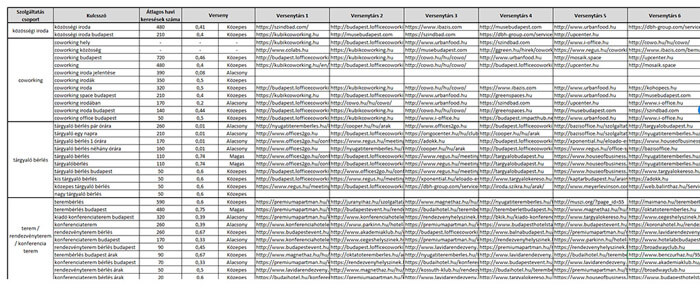
We have collected the strongest competitors for all keywords
2. Website analysis
So we know which websites are the most powerful on the web in your industry.
In this step, we examine these pages one by one (see also website analysis) and see...
- what menu items do they have
- what functionality their website has
If we include this data in a table, we will finally get an accurate list of what content and functionality you should equip your own site with based on the websites of competitors in your industry, and which of the mapped sites are the best.
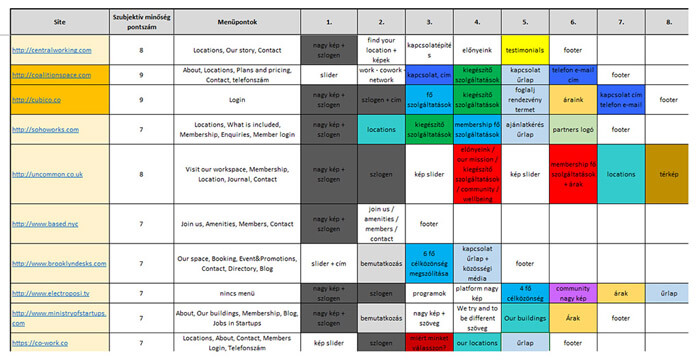
I have marked the contents of the same website with colors in order to make the table easier to understand
I can't help emphasizing to our clients that when designing their own website, competitors must also be kept in mind.
If, for example, we see that every competitor's website has a product configurator, then this function must also be integrated into your own website, otherwise you will be in a weaker position compared to the others.
3. User experience analysis
User experience (UX) has recently become one of the most important aspects when designing websites. In short, UX gives an answer to what kind of opinion and experience the visitor develops when visiting a website. If this experience is positive, you will be happy to read on the site and it is possible that you will become a customer. If the experience is negative, they usually leave the site within a short time and continue looking at a competitor.
When we examine the user experience of a site, we usually take the following main aspects into consideration:
- What is the page loading speed?
- Is the site responsive? Does it also appear perfectly on mobile?
- What is the image and appearance of the page?
- What is the quality of the page's content, language and texts?
- How is the navigation and handling of the page?
- What functions are used to achieve the set marketing goals?
- What trust-building elements are used on their website to promote engagement.
4. SEO strategy analysis
In this step, we examine the level of the competitors in terms of on-page, technical and off-page SEO, and what are the strategic elements that give certain websites an advantage over others.

Here you can see how the organic positions of a specific competitor have improved in the last period.
5. Content marketing strategy analysis
When we talk about content marketing, the word blog is the first thing that comes to mind for most people. On the website, the blog is best suited to produce regularly updated, high-quality content optimized for search engines on a specific topic and deliver it to the target audience. That is why the analysis of the blog provides a lot of useful information. We seek answers to the following questions in this section:
- Does your competitor have a blog?
- How often do you post?
- What is the quality and length of the articles displayed there?
- What keywords are the articles optimized for?
We examine whether your competitors' posts are generally about a specific topic or specifically about their products. Of course, there can be a "mixture" of these in any proportion, but in any case, it is telling what they focus on.
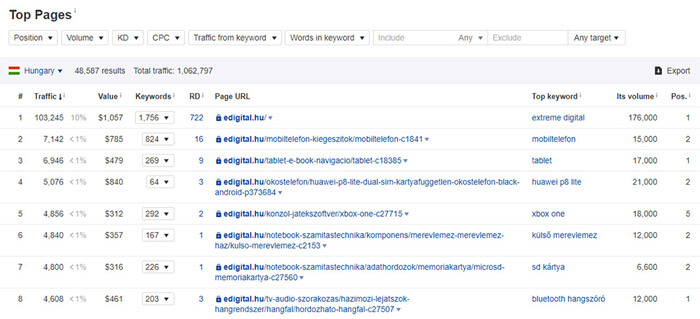
The most popular pages of edigital.hu bring in what amount of traffic from Google for how many keywords.
6. Backlink analysis
External links to the website are called backlinks. You cannot achieve good rankings without the right amount and quality of backlinks. What's more, sufficiently strong backlinks can fly even a lower-quality website to high Google positions. That is why it is important to know which competitor and what strategy they are pursuing in this area.
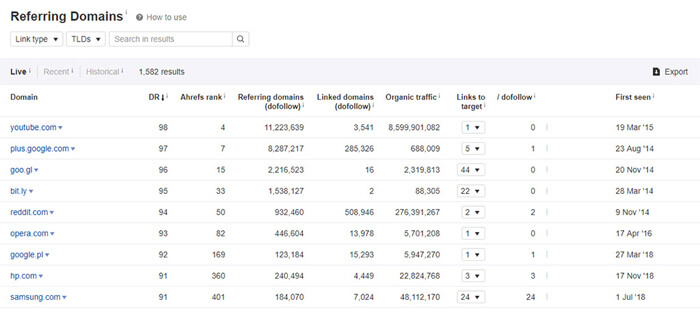
Here you see the strongest backlinks of a competitor
Getting quality backlinks is not easy (see our article on link building), so the output of this analysis will give you a lot of useful tips on where to try link building.
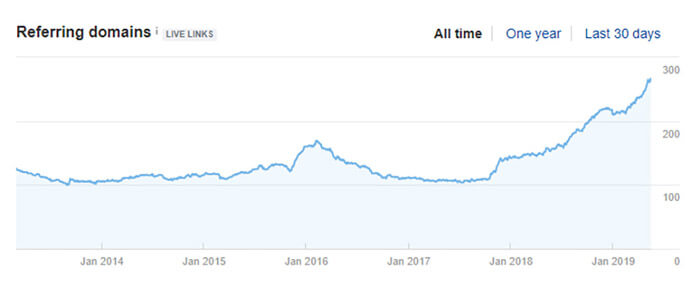
The change in the number of backlink domains over time sheds light on the link building strategy.
7. Online marketing strategy analysis
In this section, we examine the online marketing and online communication strategy of the strongest competitors. Online marketing strategy analysis includes the following areas:
- social media presence
- newsletter marketing
- PPC ads
The 5 most important things you can learn from a good competitor analysis
- Who are my real competitors on the web?
- How are my competitors' websites better, what do I need to improve on?
- What online marketing tool are my competitors using to achieve success?
- What product or service do my competitors achieve the most traffic with?
- What do I need to do to get ahead of others in the search engines?
Common pitfalls in competitor analysis
1. The competitor analysis does not have to be done only once!
It is a common mistake that companies take out the analysis that has already been completed again and again, but do not update its content, which is why they can even draw wrong conclusions from it. Your competitors, like you, are constantly analyzing the current market situation, which is why their operations and behavior are constantly changing. That is why it is most expedient to continuously update the analyses.
2. Taking into account your own prejudices and preconceptions
Most of us tend to draw hasty conclusions even with incomplete knowledge of the facts. It is important to rely on the discovered facts when preparing a competitor analysis, and not on "what you think" about your competitors. Make business decisions based on the facts you know, not based on your preconceptions.
3. Competitor analysis is worthless if you don't use its results
Preparing a thorough competitor analysis consumes a lot of time and energy, so it is important to use its findings when making your business decisions. Otherwise, it was really just a waste of money.
4. You work with it more than necessary
Nowadays, there are many useful tools available for preparing a competitor analysis. You don't have to invent "Spanish wax" and make things difficult for yourself. At Usernet, we also subscribe to several types of software, which we have selected after years of use, so we can be sure that they provide reliable results.
5. You start the competitor analysis without a specific goal
In the event that you do not have a specific goal with the competitor analysis, more precisely with its goal; you will spend much more energy on making it than necessary. Before you start collecting data, define your goal, what you hope to achieve by getting to know your competitor. Are you interested in the quality of their websites, their SEO strategy or their online advertising strategy? It is advisable to decide in advance what you are primarily interested in.
6. You do not take into account the market situation of the given period
When you do a competitor analysis, be sure to examine how your competitors have grown/changed and what decisions they have made over a longer period of time. It is a common mistake to analyze your competitor's decision only at a specific time. In the online space, the strategy of a competing company can change weekly or monthly due to the trends and economic effects of the given period. These facts must be taken into account when evaluating the results.
The final result of the competitor analysis
The end result of your online competitor analysis will be a document that presents…
- Who are your strongest online competitors?
- Which competitor is strong in what and how it achieves good results
- What strategy should you follow in order to get ahead of your competitors?
I need a competitor analysis
I would be curious about the strategy of my competitors,
I want to overtake them on the web.




